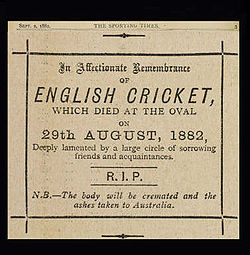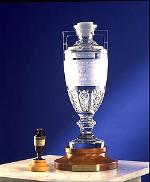The Ashes, cricket’s greatest and most enduring rivalry is played out between its two oldest protagonists, England and Australia.
The concept of this contest dates back to 1882, after England lost to Australia for the first time on home soil, a mock obituary appeared in the Sporting Times.
‘In affectionate remembrance of English cricket which died at The Oval, 29th August, 1882. Deeply lamented by a large circle of sorrowing friends and acquaintances, RIP. NB The body will be cremated and the Ashes taken to Australia.’
The English press labelled the next English tour to Australia (1882–83) as the quest to regain The Ashes.
This great contest is played out every two years, with the sides taking turns to tour each others country.
With the sides being in different hemispheres the tours take place in the home countries summer.
The series is played for over five Test matches, if the series is a draw, then the side who won the Ashes previously are deemed to have retained them.
The Ashes: Background

The background to Anglo-Australian cricket goes back further than the inception of the Ashes.
Cricket arrived in Australia when colonisation began in 1788.
Recognised cricket between these two countries began in 1868 when an Australian Aboriginal team toured England, it was the first Australian Cricket team to tour overseas.
The first Test matches are recognised as being played in 1877 when an England Team toured Australia and played two games against an Australian XI.
Australia reciprocated the next year and toured England to great success, although no Tests were played.
Then in 1882, at the Oval in South London, England lost to Australia for the first time on home soil.
Birth of the Ashes

It was this loss that was to give birth to the Ashes.
At the end of this series plans were already under way for an English tour of Australia.
The England touring party was led by Ivo Bligh, three weeks after the defeat at the Oval, Bligh set off for Australia with the England side, vowing to return with the Ashes.
There were three matches arranged to be played against the Australian national side, yet there was much social cricket played by the team, many of Englands’ cricketers were amateur players and social cricket was very much in vogue.
In the Test series, Australia prevailed in the first test but England fought back to win the next two and it was accpeted that they had regained the Ashes.
It was on Christmas Eve in 1882, after one of these social matches at Rupertwood Estate in Victoria that Bligh was presented by a group of Melbourne ladies with a small terracotta urn in a red and gold velvet bag.

It is believed that the ashes within the urn are that of a bail from the third match in the series.
There is an inscription on the urn, it reads,
‘When Ivo goes back with the urn, the urn;Studds, Steel, Read and Tylecote return, return;The welkin will ring loud,The great crowd will feel proud,Seeing Barlow and Bates with the urn, the urn;And the rest coming home with the urn.’
The urn was to symbolise the Ashes that he had vowed to regain on the Australian tour.
It was at this event that Bligh was to meet his future wife, Florence Morphy.
Bligh married Florence in February 1884 and they returned to England with the urn.
The urn was to live for the next 43 years on the mantelpiece in the Bligh family home in Kent. Bligh regarded the Urn as a personal gift and upon his death it was bequeathed to the MCC where it resides in the Lords museum.
To add some extra mystery to the Ashes legend, in 1998, Bligh’s 82-year-old daughter-in-law said she was lead to believe that the ashes within the urn were not in fact a bail, they were the remains of her mother-in-law’s veil.
Playing for the Ashes

It is tradition for the Ashes not to leave England, much to Australia’s chagrin, although the fragility of the urn probably now precludes that.
The MCC in the 1990’s picked up on the tremendous public interest in the Ashes and commissioned a trophy in the form of a Waterford crystal urn for the teams to play for.
Mark Taylor’s Australian side was the first winner of the crystal urn in 1998-99. It has been presented to the victorious captain at the conclusion of each series between England and Australia.
Back To cricketlab.co from The Ashes

About Richard Pybus
I'm Richard Pybus, I've coached Pakistan, Bangladesh, Middlesex, Titans and the Cape Cobras in South Africa and the goal of this site is to help you to play winning cricket.
